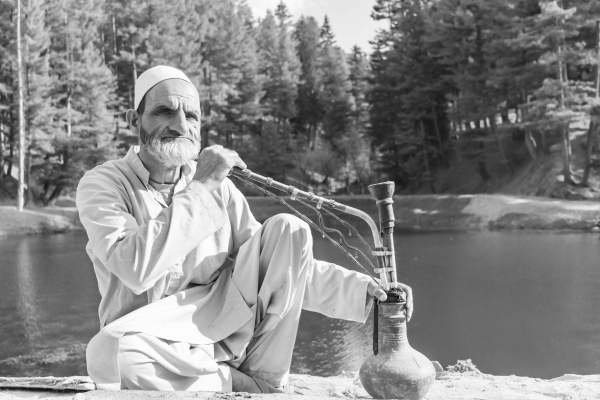Once you have crossed the mighty Pir Panjal range and entered the beautiful valley of Kashmir, there are two things that occur. You are at first overwhelmed by the abundance of life-giving earth and the absolute and enchanting beauty of your surroundings, secondly, you will note the distinct cultural & physical shift that occurred, until you could almost be mistaken in thinking you have reached central Asia.
The landscape of Kashmir is stunning and thus has been captivating Kings, Travelers, Scholars & Saints for lifetimes. As a destination, it has been entertaining tourists for nearly 200 Years. But, Kashmir has much much more to offer beyond the famed Houseboats & Shikaras (traditional Kashmiri water transport) of Dal Lake, the ski slopes of Gulmarg, and the pleasure gardens of Mughal Kings. The “old town” of Srinagar is a virtual open-air museum of architecture and material culture. The Bazaars are filled with copper smiths, cloth merchants, spice dealers, halaal butchers, traditional wood-fired bakeries, tailors, and embroiders. Situated around the river Jhelum, the mighty river which flows into Pakistan, are Mosques, Shrines, Temples & Tombs indicative of the rich religious heritage of Srinagar. Head out of the city and into the mountains you will find small gorgeous villages, nomadic people life-giving glaciers running into life-sustaining rivers, high altitude meadows, world-class ski runs, wild animals, and mighty peaks waiting to be summited.
if you locate Kashmir from a geopolitical perspective the history of not only India but the entire Central Asian region can be meditated through her. The history of Kashmir, with its subsequent layers of rites, rituals, and rulers has created the culture of today. In the time of methodology, Kashmir was an enormous lake, and the first dwellers were people of water. No religious history is at this time. But what is recorded is that located near the Wular Lake (about 2 hours drive from Srinagar) which is considered the contemporary remain of the first giant, there are giants iron hooks solved into the sides of the mountains that were used by these first water dwellers to Moore their boats; dwelling in the mountains that surrounded the lake was Naga Tribe, worshipers of the serpent. As the lake drained due to conflicts between the Gods and Men, Rishis, and Bhramens came from the Indus Valley to live there and reclaimed the land. It was here Hindu Religion 1st came to Kashmir like neighboring Afghanistan and Pakistan, and Buddhism became the next religion to captivate the people and to flourish. King Ashoka “The Great” was responsible for the propagation of Buddhist belief (around 250 BC.) at first named Ashoka “the cruel” for his predilection of torture and violent solitary, he reperformed his ways after a particularly messy battle which saw him embrace the teachings of non-violence and respect for all parts creatures. Hindu religion popped up again with the reigns of his son and grandson, but Buddhism returned for the next 200 years with the Kushan empire (1st/2nd century A D) the Kushans were a collection of people from the very west of china who swept through Central Asia, down into India and across to the Bay of Bengal. They created to trade with the “Silk Route”, peace with Buddhism, and stability with coin. Kashmir and its surroundings became the seat of Buddhist learning and religious scholarship.
To know more about Kashmir visit: https://www.ahangerhobo.com
Shaivism worship of the God Shiva and a form of Hinduism dominated the valley after the decline of Buddhism. In Kashmir Shaivism all things are manifestations of universal, consciousness and the goal of Kashmiri Shaivism is to merge in Shiva or universal consciousness or realize one’s already existing identity with Shiva. The most famous Shaivite of Kashmir was Lalleshwari, (Lal Ded). She was a mystic and poet and she created some of the earliest compositions in the Kashmiri language which now hold an important position in the canon of Kashmiri Literature. she inspired many of the later Sufis of Kashmir including the patron saint of Kashmir, Nundrishi.
Islam came to Kashmir in the very beginning through the Ladakhi King Rinchen (widely known as Rinchen Shah) who was ultimately impressed by the simple teaching of Sufi Islam from Bulbul Shah, beloved poet of Kashmir and the first Muslim faqeer to visit the valley, converted to Islam to consolidate his reportedly otherwise week position as a foreign ruler of the kingdom of Kashmir. The Sufi teachings which were spreading east from Persia through modern-day Afghanistan, Pakistan, and into India, resonated with the local Buddhist and Hindu populations. They taught that man should strive to be with God (Experience God directly) and have no attachments to this world. Sufism became the common ground between all, promoting the unity of all being and all religions. If were to be a single man that influenced the culture of Kashmir and Kashmiri Islam it would be Mir Syed Ali Hamadani. The Persian Sufi, to avoid persecution in his homeland, move to Kashmir with 700 followers during the reign of King Shahab-uddin (1354 to 1373). in Kashmir, Hamadani started to preach Islam in a peaceful and organized manner and with his followers built many Mosques in the Valley. The beautiful Papier Mache, mosque Shah-i-Hamdan, in the old town is dedicated to his memory.
Islam continued to separate through the mouths of a holy man in the valley, and a series of great Islamic Kings from Sultan Zain-Ul-Abidin in 1420 to the famed Mughal rulers who reigned throughout northern India from 1586 to 1753, consolidated Islam as the state religion. After the Mughals, the Afghans (1762–1819), the Sikhs (1819–1846), and then the puppets rulers of the British, the Dogras from the next Kingdom of Jammu ruled Kashmir, until the time of the partition of India in 1947. After 1947 Kashmir’s status remained disputed with the UN. the 2 newborn states, India and Pakistan claimed it to be theirs. this led to 3 wars and later in 1990, a mess uprising took place which claimed thousands of Kashmiri Lives. This political uncertainty over decades severely impeded Kashmiri’s development and unbelievably it still remains a seriously electricity-deficient region though situated in a hydropower potential zone. The dispute over Kashmir has been the cause whether directly or indirectly of all major conflicts between the 2 countries with the exception of the Bangladesh war of 1971.
Up to the present Kashmir remain a major Muslim State, Administrated by 2 states Pakistan and India. the conflict over Kashmir remains unresolved. not only was Kashmir’s religion imported and molded through various rulers over the centuries, but particularly influential has been Persian Culture which is still obvious from such examples as the sweet and spicy Kehwa Tea to guests to the majestic chinar trees living in the valley. Among the 700 followers who accompanied Mir Syed Ali Hamdani to Kashmir, many were men of the arts and crafts. They popularized shawl making, Carpet manufacturing, cloth weaving, pottery, and calligraphy. from the 1400 century, the Persian Language exerted enormous influence on the intellectual elite and was the official court language. For 500 years hereafter Persian was a primary medium for literary production in all fields of learning and poetry.
Continuous efforts to develop Persian at that time the availability of locally produced, high-quality paper and the constant influx of Iranian Scholars earned Kashmir the title Iran-E-Sagar “Little Iran”. Persian was replaced by Urdu in 1889, and Urdu remains to this day as the official state language.
Srinagar Taxi Services | Srinagar Airport Taxi Services | Kashmir Travel Package | Kashmir Vlog | Travel Consultant for Kashmir | Kashmir Trip
What to do in Kashmir Trip?
Book a hotel in Kashmir?
Budget Hotel In Kashmir?
Things to do in Kashmir?
Gondola Ticket Availability
Get all solution under one umbrella. Call now +91 7006474372 | 9541117773 | 9541115558


0 Comment